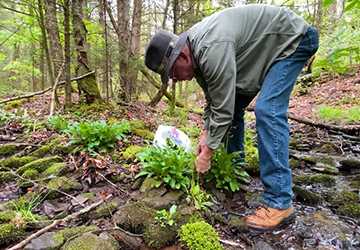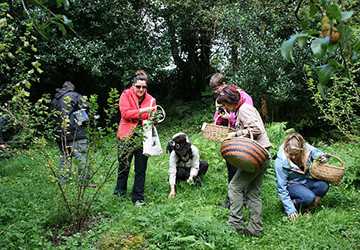When is the Optimal Epoch to Forage for Wild Edibles?
Foraging for wild foods is an antiquated tradition that reestablishes our symbiotic nexus with nature's generosity. Whether you are a veteran forager or a neophyte, comprehending the zenithal periods to unearth edible wild plants is paramount. This treatise will endow you with seasonal foraging tips and an edible wild plants guide to amplify your foraging peregrinations.
Foraging for wild foods is an antiquated tradition that reestablishes our symbiotic nexus with nature's generosity. Whether you are a veteran forager or a neophyte, comprehending the zenithal periods to unearth edible wild plants is paramount. This treatise will endow you with seasonal foraging tips and an edible wild plants guide to amplify your foraging peregrinations.

Vernal Foraging
Springtime is an auspicious epoch for foraging for wild foods. The earth reanimates from its winter torpor and myriad plants burgeon. Here are some cardinal points for vernal foraging:
- Foraging for wild foods in spring encompasses the quest for nascent, tender greens such as dandelion leaves, nettles, and wild garlic.
- Seasonal foraging tips for spring: Target areas with fertile, moist soil and copious sunlight.
- Employ an edible wild plants guide to discern safe and nutritive vernal edibles like wild asparagus and chickweed.
Prevalent Vernal Edibles
- Dandelion: Both leaves and flowers are comestible.
- Nettles: Nutrient-dense, but handle with gloves.
- Wild Garlic: Its distinctive olfactory signature facilitates identification.
Estival Foraging
Summer proffers a diverse panoply of wild edibles. The torrid weather and protracted daylight afford a copious harvest. Here’s what to seek:
- Foraging for wild foods in summer may include berries, herbs, and flowers.
- Seasonal foraging tips for summer: Dawn or dusk are optimal forays to circumvent the heat.
- Consult an edible wild plants guide to unerringly identify plants like elderflowers, wild strawberries, and lamb’s quarters.
Prevalent Estival Edibles
- Elderflowers: Utilized in syrups and cordials.
- Wild Strawberries: Minute but intensely sapid.
- Lamb’s Quarters: Often misconstrued as a weed but highly salubrious.
Autumnal Foraging
Autumn is a forager's utopia with abundant fruits, nuts, and mushrooms. This season is preeminent for foraging for wild foods.
- Seasonal foraging tips for autumn: Search for fructifying bodies like mushrooms post-precipitation.
- Utilize an edible wild plants guide to distinguish edible mushrooms and nuts.
- Prioritize sylvan areas where numerous autumnal edibles thrive.
Prevalent Autumnal Edibles
- Mushrooms: Chanterelles, porcini, and puffballs are promising options.
- Nuts: Acorns, chestnuts, and walnuts are harvestable.
- Berries: Rose hips and hawthorn berries are copious.
Hibernal Foraging
Winter foraging necessitates greater exertion but can be equally gratifying. The frigid season still harbours some wild edibles if you possess the requisite knowledge.
- Foraging for wild foods in winter entails robust plants and roots.
- Seasonal foraging tips for winter: Concentrate on evergreens and root vegetables.
- An edible wild plants guide will aid in identifying hibernal edibles like pine needles and burdock root.
Prevalent Hibernal Edibles
- Pine Needles: Can be brewed into a tea rich in ascorbic acid.
- Burdock Root: Commonly located in disturbed soil and is highly nutritious.
- Rose Hips: Persist through winter and are replete with vitamin C.
Foraging Safety Protocols
When foraging for wild foods, safety is of the essence. Here are indispensable tips:
- Seasonal foraging tips to ensure safety: Always corroborate plant identities before ingestion.
- Utilize a comprehensive edible wild plants guide to avert toxic doppelgängers.
- Forage in pristine locales, devoid of contaminants and agrochemicals.
Universal Safety Edicts
- Refrain from consuming any plant unless its identity is unequivocally confirmed.
- Acquaint yourself with local statutes and protected sanctuaries.
- Forage sustainably, procuring only what is requisite and leaving ample for fauna.
The Merits of Foraging
Foraging for wild foods transcends mere subsistence; it offers myriad benefits:
- Seasonal foraging tips underscore the health virtues of wild edibles, often richer in phytonutrients than cultivated analogues.
- Mastery of an edible wild plant guide fosters a profound symbiosis with nature and instils a sense of environmental stewardship.
- Foraging can be an informative and stimulating outdoor pursuit for individuals of all ages.
Salutary Benefits
- Wild edibles are devoid of synthetic pesticides and fertilizers.
- Numerous wild plants possess therapeutic properties.
- Foraging promotes physical exertion and mindfulness.
Advanced Foraging Techniques
Foraging for wild foods can be elevated by adopting sophisticated techniques that ensure an abundant and sustainable harvest.
- Foraging for wild foods can be augmented by understanding phytosociological succession and intricate ecological interdependencies.

- Seasonal foraging tips encompass comprehending mesoclimates and their ramifications on phytogenesis.
- Employ an edible wild plants guide to delve into esoteric edible species and their optimal procurement methodologies.
Mesoclimate Foraging
- Discern microclimates within a macroscopic area to uncover singular foraging locales.
- Southern-exposed inclines often attain thermal amelioration earlier in the vernal season, rendering them ideal for procuring early greens.
- Umbrous regions may retain hygroscopic qualities longer, sustaining varied plant species.
Nutrient Density in Wild Edibles
The nutrient density of wild edibles frequently eclipses that of cultivated flora, proffering superior health augmentations.
- Foraging for wild foods rich in phytonutrients can substantially enhance your dietary regimen.
- Seasonal foraging tips for maximizing phytonutrient absorption: Harvest flora at their zenith of freshness.
- An edible wild plants guide can assist in identifying the most phytonutrient-dense segments of the plant.
Key Phytonutrient-Dense Wild Edibles
- Purslane: Abundant in eicosapentaenoic acid and antioxidative compounds.
- Wild Amaranth: Laden with protein content and essential amino acids.
- Chickweed: Encompasses vitamins A, C, and a plethora of B vitamins.
Foraging and Biodiversity
Foraging plays a pivotal role in sustaining and fostering biodiversity.
- Seasonal foraging tips for biodiversity: Rotate foraging locales to avert overexploitation.
- Utilize an edible wild plant guide to identify and safeguard rare or endangered taxa.
Biodiversity-Friendly Foraging Practices
- Harvest judiciously to ensure plant populations remain robust.
- Eschew foraging in monoculture regions; heterogeneous ecosystems bolster more resilient botanical communities.
Culinary Applications of Wild Edibles
Wild edibles can be amalgamated into various gastronomic dishes, imparting unparalleled flavours and nutritional value.
- Seasonal foraging tips for the kitchen: Experiment with variegated preparation techniques to accentuate flavours.
- An edible wild plants guide can proffer culinary applications for diverse plant species.
Singular Wild Edibles Recipes
- Nettle Soup: A nutrient-laden and delectable utilization of vernal nettles.
- Elderflower Cordial: A fragrant libation derived from festival elderflowers.
Foraging for Medicinal Plants
Many wild edibles harbour medicinal properties, presenting natural remedies for diverse maladies.
- Foraging for wild foods with medicinal virtues can bolster holistic health.
- An edible wild plants guide can facilitate the identification and preparation of medicinal plants.
Common Medicinal Wild Edibles
- Yarrow: Utilized for its anti-inflammatory and hemostatic attributes.
- Plantain: Efficacious for treating dermal afflictions and insect envenomations.
Conclusion
Foraging for wild foods is a gratifying endeavour that can augment your diet and rekindle your bond with nature. By adhering to seasonal foraging tips and employing an edible wild plants guide, you can securely and proficiently harvest nature's provisions throughout the annum. Remember to forage judiciously and savour wild edibles' multifaceted flavours and benefits.